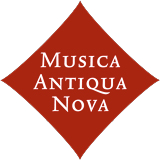Live recordings of Early Music concerts. This episode will feature three, very different, live concerts. Please enjoy French religious baroque music performed by Les Tendres Plaintes, early German classical music by Trio Marie Soldat and Italion renaissance brass music byI Fedeli.
A) Part 2 of Les Tendres Plaintes – “Tristis est anima mea”, Leçons de Ténèbres by François Couperin and other French music for Holy Week.
“Among the 18th-century French settings of the Lamentations of Jeremiah, the so-called ‘Leçons de Ténèbres,’ the version by François Couperin is one of the most famous. Understandably so—the angelic arrangement with one or two sopranos, the long, elegant cantilenas that intertwine in sweet harmonies and poignant dissonances—this style was very popular in the 18th century, garnering significant public acclaim. These texts from the Lamentations belong to the Nocturnes of the three days before Easter: Maundy Thursday, Good Friday, and Holy Saturday. They are typically grouped into sets of three ‘Leçons’ for each day, often presented in an elaborate musical setting. In the early 18th century, music during Holy Week was nearly banned everywhere except at the Longchamp Abbey, just outside of Paris. Here, services still featured extensive musical performances. As a result, large crowds would flock to Longchamp during Holy Week to attend an Office des Ténèbres. For convenience, these services, which were originally meant to take place shortly after midnight, were rescheduled to the afternoon of the preceding day. And so, visiting Longchamp became a very popular destination. Only the first set of lamentations by Couperin, intended for Maundy Thursday, has survived. In line with tradition, it bears the title ‘Pour le Mercredy’ (Wednesday). For this concert, the Leçons de Ténèbres by François Couperin, which is performed after the intermission, are combined with vocal music by M.A. Charpentier and F. Couperin, which might also have been heard in an Office des Ténèbres or another church service during that period. The program is further complemented with suitable instrumental works. And why the name Ténèbres? Ténèbres means ‘darkness’. The name likely originated because, during these services, candles were extinguished one by one until it was almost completely dark.”
François Couperin (1668-1733)
From Ténèbres pour le Mercredi Saint (1714):
1. Première Leçon à une voix
2. Deuxième Leçon à une voix
3. Troisième Leçon à deux voix
Les Tendres Plaintes: Tanja Obalski and Bethany Shepherd, soprano. Marike Tuin, viola da gamba. Robert Koolstra, harpsichord
Recording: Lekkum 21 March 2024, Cecilia-kerk Lekkum
Tech: Hans Beek
B) Trio Marie Soldat – Piano trios by Haydn and Romberg
Bernhard Romberg (1767-1841)
4. Duo for Violin and Cello: “Se vuol ballare” (From ‘Le nozze di Figaro’ van Mozart)
Joseph Haydn (1732-1809)
5. From Sonate no. 32, Hob. XVI/44: Moderato
6. Piano trio no. 39 in G major, Hob. XV/25 “Gypsy trio”
Ignace Joseph Pleyel (1757-1831)
7. From Trio Op.16 no. 5 e minor: Andantino
Trio Marie Soldat: Cecilia Bernardini, violin. Marcus van den Munckhof, cello. Keiko Shichijo, pianoforte (Paul McNulty, 1995, after Anton Walter, 1782)
Recording: Sunday 10 March 2024, Lutheran church Groningen
Tech: Martijn Reneman, production: Peter Terpstra
C) I Fedeli – ‘Gemma Musicalis: The Italian Influence on Europe’
“Until the end of the 16th century, music north of the Alps was predominantly of the Franco-Flemish style. Gradually, Italian music improved and gained more recognition, beginning to influence the new generation of composers from across the Alps.
This led to a new and extravagant Baroque style at the major European courts. Gemma Musicalis (Nuremberg, 1588-1590) is a selection of Italian Renaissance music, published in three parts by Friedrich Lindner and carefully curated to reach a broad German-speaking audience. Lindner was one of the most productive authors of Italian music in Germany and undoubtedly played a significant role in introducing Italian poetic and musical culture to the courts of Bavaria.
L Fedeli follows into the footsteps of the Stadtpfeifer, a group of musicians in Germany who played wind instruments and provided music for both public and private events, as well as for religious festivals. The instrumentation offers a wealth of sounds and was also a commonly heard combination among the Stadtpfeifer.
The aim of the ensemble is to revive this tradition of playing wind instruments, as was once very common in many European countries such as Spain (‘ministriles’), Italy (‘piffari’), and England (‘town waits’), but unfortunately is rarely heard today.
This programme will showcase the repertoire of such ensembles across Europe and demonstrates how Italian music gained more influence during the 16th century”
William Brade (1560-1630)
8. Paduana Galliard
Christopher Tye (1505-1572)
9. In NomineX
William Byrd (1540-1623)
10. Toccata
Giovanni Coprario (1570-1626)
11. Fantasia
Josquin Desprez (1450-1521)
12. Mille Regrets (orgel en zink)
Thomas Stoltzer (1480/5-1526)
13. Melodiae, Tertii toni a 5
Ludwig Senfl (c.1486-1542/3)
14. Will niemand singen a 5
Henrich Isaac (1450-1517)
15. La my
Ludwig Senfl (1486-1542/3)
16. Ich stund an einem Morgen
17. Tandernak a 5
Francisco Guerrero (1528-1588)
18. Que buen año es el del cielo a 3
19. Niño Dios d’amor a 4
Josquín Desprez
20. Kyrie
Anonymous
21. Si la noche haze escura
I Fedeli: Josue Melédez, cornett & tenor cornett. Gawain Glenton, cornett. Catherine Motuz, trombone. Ann Allen, pommer. Nora Hansen, dulcian. Javier Núñez, organ
Recording: 14 March 2010, Luthean church, Groningen
Tech and organisation: Musica Antiqua Nova
Pictured above: I Fedeli
Special thanks to Musica Antiqua Nova.









